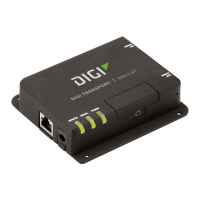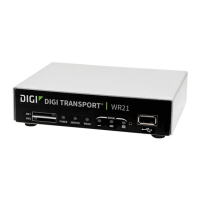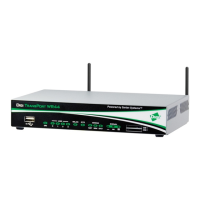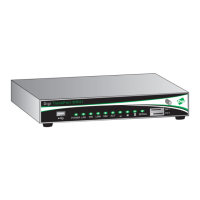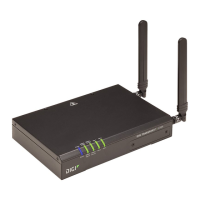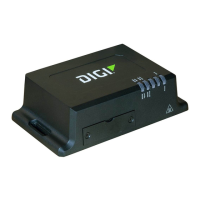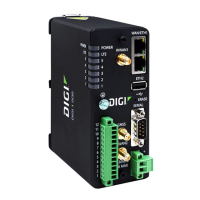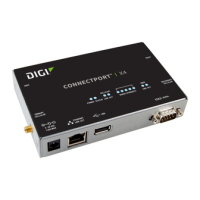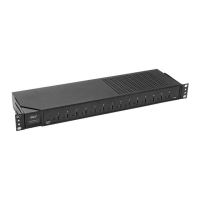Do you have a question about the Digi TransPort WR31 and is the answer not in the manual?
Details the TransPort WR11 router, a full-featured cellular router for WAN connectivity.
Details the TransPort WR21 router, a full-featured cellular router for WAN connectivity.
Details the TransPort WR31, an intelligent 4G LTE router for critical infrastructure and industrial apps.
Details the TransPort WR41, an all-in-one mobile communications solution with advanced features.
Details the TransPort WR44, an all-in-one mobile communications solution with advanced features.
Details the TransPort WR44 RR, a rugged enterprise-class cellular router for rail environments.
Guides users through the process of accessing the router's web interface using a web browser.
Details the steps to connect to the router's command line interface using terminal emulation software.
Explains how to log in to the router's command line interface using default credentials.
Provides CLI commands for configuring the router's IP address and subnet mask.
Details AT commands and Special registers (S registers) for modem compatibility and router configuration.
Explains text-based application commands specific to Digi International products for router control.
Explains how to configure IP address, mask, gateway, and other parameters for Ethernet interfaces.
Details configuring Wi-Fi features, including global settings, country, network mode, and channel.
Covers configuring mobile WAN modules, including APN, PIN, username, and password settings.
Explains how to configure DSL/ADSL functionality, including PVC parameters and encapsulation methods.
Details configuring Generic Routing Encapsulation (GRE) tunnels for IP packet transport.
Explains how to configure ISDN interfaces for incoming calls, including answering parameters.
Details configuring PSTN interfaces for connecting to the public switched telephone network.
Explains how to configure DialServ interfaces for telephone exchange functionality and modem data handling.
Covers configuring IP routing and forwarding, including static routes, RIP, OSPF, BGP, and VRF.
Details configuring VPNs, including IPSec tunnels, PPTP, and OpenVPN for secure network connections.
Details parameters for configuring the SSH server, including TCP port, login attempts, and compression.
Details parameters for configuring SSH clients, including handshake time, known_hosts, and identity filenames.
Covers system security settings, including USB security and miscellaneous security options.
Details user security settings, allowing configuration of authorized users, passwords, and access levels.
Explains how to configure firewall settings, including rules, parameters, and script syntax.
Covers RADIUS client configuration for authentication and accounting purposes.
Details TACACS+ parameters for controlling access to the router via AAA services.
Displays current status and statistics for Ethernet, Wi-Fi, Mobile, DSL, GRE, ISDN, PSTN, DialServ, Serial interfaces.
Covers managing IP connections, including TCP sockets and general purpose sockets.
Covers managing files on the router's flash file system, including copying, deleting, and renaming.
Explains how to update the router's firmware using a .zip file downloaded from the Digi website.
Describes how to reset the router's configuration to factory defaults via the web interface or hardware button.
Covers saving the router's configuration settings to non-volatile memory (config.da0/config.da1).
Provides troubleshooting steps for issues with accessing the router's web interface.
Offers solutions for login issues with the router's web interface, suggesting CLI access as an alternative.
Details the TransPort WR11 router, a full-featured cellular router for WAN connectivity.
Details the TransPort WR21 router, a full-featured cellular router for WAN connectivity.
Details the TransPort WR31, an intelligent 4G LTE router for critical infrastructure and industrial apps.
Details the TransPort WR41, an all-in-one mobile communications solution with advanced features.
Details the TransPort WR44, an all-in-one mobile communications solution with advanced features.
Details the TransPort WR44 RR, a rugged enterprise-class cellular router for rail environments.
Guides users through the process of accessing the router's web interface using a web browser.
Details the steps to connect to the router's command line interface using terminal emulation software.
Explains how to log in to the router's command line interface using default credentials.
Provides CLI commands for configuring the router's IP address and subnet mask.
Details AT commands and Special registers (S registers) for modem compatibility and router configuration.
Explains text-based application commands specific to Digi International products for router control.
Explains how to configure IP address, mask, gateway, and other parameters for Ethernet interfaces.
Details configuring Wi-Fi features, including global settings, country, network mode, and channel.
Covers configuring mobile WAN modules, including APN, PIN, username, and password settings.
Explains how to configure DSL/ADSL functionality, including PVC parameters and encapsulation methods.
Details configuring Generic Routing Encapsulation (GRE) tunnels for IP packet transport.
Explains how to configure ISDN interfaces for incoming calls, including answering parameters.
Details configuring PSTN interfaces for connecting to the public switched telephone network.
Explains how to configure DialServ interfaces for telephone exchange functionality and modem data handling.
Covers configuring IP routing and forwarding, including static routes, RIP, OSPF, BGP, and VRF.
Details configuring VPNs, including IPSec tunnels, PPTP, and OpenVPN for secure network connections.
Details parameters for configuring the SSH server, including TCP port, login attempts, and compression.
Details parameters for configuring SSH clients, including handshake time, known_hosts, and identity filenames.
Covers system security settings, including USB security and miscellaneous security options.
Details user security settings, allowing configuration of authorized users, passwords, and access levels.
Explains how to configure firewall settings, including rules, parameters, and script syntax.
Covers RADIUS client configuration for authentication and accounting purposes.
Details TACACS+ parameters for controlling access to the router via AAA services.
Displays current status and statistics for Ethernet, Wi-Fi, Mobile, DSL, GRE, ISDN, PSTN, DialServ, Serial interfaces.
Covers managing IP connections, including TCP sockets and general purpose sockets.
Covers managing files on the router's flash file system, including copying, deleting, and renaming.
Explains how to update the router's firmware using a .zip file downloaded from the Digi website.
Describes how to reset the router's configuration to factory defaults via the web interface or hardware button.
Covers saving the router's configuration settings to non-volatile memory (config.da0/config.da1).
Provides troubleshooting steps for issues with accessing the router's web interface.
Offers solutions for login issues with the router's web interface, suggesting CLI access as an alternative.
| 3G | Yes |
|---|---|
| 4G | - |
| 2G standards | EDGE, GPRS |
| 3G standards | HSPA+ |
| GSM bands supported | 850, 900, 1800, 1900 MHz |
| UMTS bands supported | 850, 900, 1700, 1900, 2100 MHz |
| Antennas quantity | 2 |
| Antenna connector type | SMA dipole |
| Security algorithms | HTTPS, SNMP, SNMPv3, SSH |
| USB 2.0 ports quantity | 1 |
| Ethernet LAN data rates | 10, 100 Mbit/s |
| Ethernet LAN interface type | Fast Ethernet |
| Product type | Tabletop router |
| Product color | Black |
| Housing material | Aluminum |
| Output voltage | 9 - 30 V |
| Power source type | DC |
| Power consumption (typical) | 4 W |
| Storage temperature (T-T) | -40 - 85 °C |
| Operating temperature (T-T) | -34 - 74 °C |
| Operating relative humidity (H-H) | 5 - 95 % |
| WLAN data transfer rate (max) | - Mbit/s |
| Depth | 127 mm |
|---|---|
| Width | 89 mm |
| Height | 51 mm |
| Weight | 500 g |
